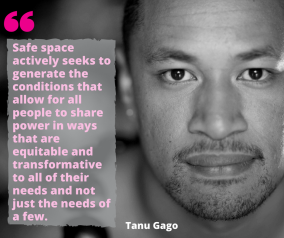Dream talks in Southside spaces

Photo by Raymond Sagapolutele
We sat on a Fijian mat, beneath a Tongan barkcloth, opposite a Cook Islands Tīvaevae. I invited three respected peers, friends and colleagues into a safe space to discuss the notion of safe space, within the arts and cultural sectors that we work within here in Aotearoa New Zealand.

Photo by Raymond Sagapolutele
#RealTalk: Safe Space / Best Practice was an event developed upon invitation from ARTSPACE, a Creative New Zealand funded contemporary art gallery in central Auckland. The event sat within the Amor Mundi conversation series, ours was the first event to take place outside of the Karangahape Road / central Auckland environment. In an opening address, outgoing curatorial Director Misal Adnan Yıldız spoke about the purpose of our discussion in a wider arts community context, referencing the exhibition, U Can’t Touch This, part of the 2015 PIMPI Winter Series, as an example of dislocating and relocating art and exhibition making.
The old Ōtāhuhu Library was the ideal location for this talanoa. Now used as a mixed use community facility, the building is currently leased to the Ōtāhuhu Māngere Youth Group who coordinate free programmes from vogue workshops to homework sessions and music classes. It is safe space embodied.

Photo by Ema Tavola
After a round of introductions from the audience, the conversation started with a knowing of the presence in the room. The panel talked story, sharing experiences and insights of safety and conflict, risk, passion and frustration. The discussion went from: advocating in museums and symposia around the world, to the simple gesture of inviting people to step inside at community galleries in South Auckland, to personal safety, and the real, physical, harmful behaviour which affects the lives of Pacific Rainbow communities every day.
Kolokesa Māhina-Tuai spoke of tā-vā theory of reality in relation to the conflict, chaos and harmony in the space between real talk / unreal talk, safe space and unsafe space, best practice and worst practice.

Photo by Raymond Sagapolutele
In conversation with the audience, the panel unpacked the meaning and mana of tears, of emotional intelligence and the problematic translation of emotional responsiveness to weakness and the problematic dichotomies of reason versus emotion, thinking versus feeling.
On tokenism and the risks of audience participation as superficial social experimentation, on the recognition of Tangata Whenua at the core of any discussion of diversity, and the safety provided by peers and those who stand side-by-side in times of conflict, and order.
There was so much value in this discussion. It was rich and insightful, poetic and emotional.

Photo by Raymond Sagapolutele
Many thanks to Caroline and the team at Ōtāhuhu Māngere Youth Group and to Christine O’Brien from Māngere-Ōtāhuhu Local Board for helping to get things moving! Thank you to ARTSPACE and the vision, courage and appetite of Misal Adnan Yıldız, thank you for creating the platform for this kaupapa, I really hope the important work you have done will continue and evolve, and we all wish you so much good luck for the next chapter.

Photo by Ema Tavola
Thank you to the panel, Tanu Gago, Leilani Kake and Kolokesa Māhina-Tuai – thank you for always bringing A-game, doing what you do, always advocating hard, representing our broader communities with passion, and changing the game in small ways every day.
Thank you to Raymond Sagapolutele for recording the event beautifully, as always, thank you for your generosity of presence. And thank you to Claudia Rakoia of Lime Espresso Bar & Eatery, who nourished us heartily with a beautiful spread.










